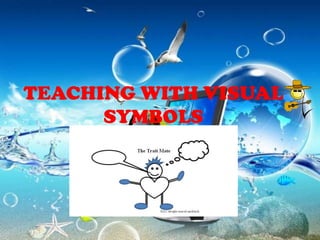
Eductechreport
- 1. TEACHING WITH VISUAL SYMBOLS
- 2. GRAPH • A graph is worth a thousand words such as – drawings, – cartoons, – strip drawings, – diagrams, – and maps • They are more clearly understood than mere words.
- 3. A. DRAWINGS • It may not be a real thing but better to have a concrete visual aid than nothing. • It is good that our drawing correctly represents the real thing. • Example is stick drawings
- 4. B. CARTOONS • A first-rate cartoon tells its story metaphorically. • The perfect cartoon needs no caption. • The symbolism conveys the message.
- 5. C. STRIP DRAWINGS • It is commonly called comic or comic strip.
- 6. Where to Use Strip Drawing in instruction? MOTIVATION ACTIVITY
- 7. SOURCES OF STRIP DRAWING NEWSPAPERS MAGAZINES BOOKS
- 8. D. DIAGRAMS • Any line drawing that shows arrangement and relations as of parts to the whole, relative values, origins and development, chronological fluctuations, and distribution. • To emphasize the key points in your diagram, make use of color.
- 9. TYPES OF A DIAGRAM A.AFFINITY DIAGRAM Used to cluster complex apparently unrelated data into natural and meaningful groups.
- 10. B. TREE DIAGRAM Used to chart out, in increasing detail, the various tasks that must be accomplished to complete a project or achieve a specific goal.
- 11. C. FISHBONE DIAGRAM It is also called cause-and-effect diagram. It is structured form of brainstorming that graphically shows the relationship of possible causes and sub causes directly related to an identified effect/problem. It is commonly used to analyze work- related problems.
- 12. E. CHARTS • A diagrammatic representation of relations among individuals within an organization. We have 7 charts: 1.Time chart 2.Tree or Stream chart 3.Flow chart 4.Organizational chart 5.Comparison and contrast chart 6.Pareto chart 7.Gantt chart
- 13. 1. TIME CHART • Is a tabular time chart that presents data in ordinal sequence
- 14. 2. TREE or STREAM CHART • Depicts development, growth and change by beginning with a single course (the trunk) which spreads out into many branches; or by beginning with the many tributaries which c then coverage into a single channel.
- 15. 3. FLOW CHART • Is visual way of charting or showing a process from beginning to end. • It is means of analyzing a process. • By outlining every step in a process, you can begin to find inefficiencies or problems.
- 16. 4. ORGANIZATIONAL CHART • Shows how one part of the organization relates to other parts of the organization.
- 17. 5. COMPARISON and CONTRAST
- 18. 6. PARETO CHART • A type of bar chart, prioritized in descending order of magnitude or importance from left to right. • It shows at a glance which factors are occuring.
- 19. 7. GANNT CHART • Is an activity time chart.
- 20. F. GRAPHS • FOUR TYPES OF GRAPHS 1. Circle or Pie graph 2. Bar graph 3. Pictorial graph 4. Line graph
- 21. 2. BAR GRAPH • Used in comparing the magnitude of similar items at different ties or seeing relative sizes of the parts of a whole.
- 22. 1. PIE GRAPH • Recommended for showing parts of whole.
- 23. 3. PICTORIAL GRAPH • Makes use of picture symbols.
- 24. 4. LINE GRAPH
- 25. G. MAPS • A representation of the surface of the earth or some part of it.
- 26. Kinds of Map 1. Physical map Combines in a single projection data like altitude, temperature, rainfall, precipitation, vegetation, and soil.
- 27. 2. Relief map Has three dimensional representations and show contours of the physical data of the earth or part of the earth.
- 28. 3. Commercial or economic map Also called product or industrial map since they show land areas in relation to the economy.
- 29. 4. Political map Gives detailed information about country, province, cities and towns, roads and highways. Oceans, rivers and lakes are the main features of most political maps.
- 31. Understanding maps and graphs 1. Read the titles and subtitles 2. Read the key, and/or the legend, and the scale of miles whenever any of these is present 3. Read the information shown along the side and the bottom of graphs and charts and tables, if any. 4. Determine your purpose for reading the map, chart, table, or graph.